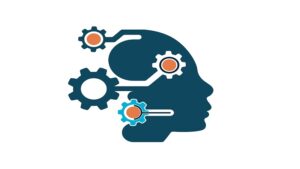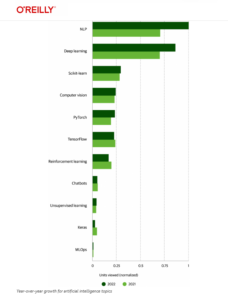
The Demand for AI/ML Skills Is Growing

(ClipPrint/Shutterstock)
The digital skills gap persists, with a growing number of workers unprepared for the continuing digital transformations of companies around the globe and across business sectors. And right now, the shortage is particularly acute in artificial intelligence, which has taken off recently with the popularity of OpenAI’s GPT-3 and ChatGPT. A recent survey by analytics firm SAS found that 63% of decision-makers said their biggest skills shortage was in AI and machine learning (ML).
The release of GPT-3 and ChatGPT, along with news about similar projects underway from Google, Meta, and others has put natural language processing (NLP), designed to help machines understand the meaning of text and spoken words, at the forefront of AI research. ChatGPT’s celebrity has spiked interest in NLP and deep learning, and that interest is likely to grow as new generative AI tools appear for use in a variety of business applications.
The growing fascination with the potential of AI and ML tools is evident in the findings of O’Reilly’s recent Technology Trends for 2023 report, which examines the most sought-after technology topics consumed by the 2.8 million users on O’Reilly’s online learning platform. By analyzing what platforms users are learning about every day, the report identifies trends in the technology and business landscape that could shape the coming year.
These trends are important to track, especially as more organizations turn towards reskilling and upskilling efforts to ensure their workforces can help them keep up with the trends – in the SAS survey, 75% of decision-makers said training and upskilling staff is their top method for closing the skills gap. As usage of low-code and no-code tools grows, training will be increasingly important to implement.
In further studies conducted by O’Reilly, we found that the biggest struggle for developers working with new tools is training (34%), followed by ease of use (12%). While these tools are increasingly AI-based, they aren’t necessarily simple. The skills needed to use them include analytical thinking, testing, and debugging.
Natural Language Processing Takes the Point
A clear sign of ChatGPT’s impact is in the interest O’Reilly users showed in NLP, which had the highest year-over-year growth at 42%, and in deep learning, which followed at 23%. NLP has a lot of uses, ranging from automated chat servers to code generation and writing tools, so the interest isn’t surprising. Developers have also increasingly searched for content related to transformers, the AI model that has helped fuel NLP, further reflecting the impact of GPT-3 and ChatGPT. Interest in NLP and deep learning will only increase as the potential for these offerings grows and new projects appear.
Chatbots are a “victim” of the growing interest in NLP and deep learning; they showed a 5.8% year-over-year decline in usage. That result may initially seem counterintuitive, but makes sense in light of the watershed impact of GPT-3’s release, which made everything that preceded it seem out of date.
ChatGPT’s future will depend on how it and its relatives are commercialized as it becomes a fee-based service and as Microsoft and Google take steps towards their own chat-based search tools.
The Tools of AL and ML Are Drawing Attention
Developers and researchers also showed continued interest in Scikit-learn, a relatively old but actively maintained tool that also has the most popular library. Its usage increased by 4.7% from the year before.
Overall usage of PyTorch and TensorFlow is roughly equivalent to that of Scikit-learn (with PyTorch slightly ahead), but those two could be heading in different directions. PyTorch now has momentum, increasing by 20%, while TensorFlow decreased by 4.8%. Meanwhile, Keras, a front-end library that uses TensorFlow, dropped 40%. However, the real winner will be the public programming APIs for ChatGPT, Bard, and other language models. These APIs are already spawning a new generation of AI-driven applications.
Another notable development is the decreased interest in MLOps, for which usage dropped by 4%. MLOps focuses on streamlining the process of taking ML models to production and following up by maintaining and monitoring them. This would seem to fill an important role of integrating AI and ML applications into deployments for other IT applications.
However, MLOps is still immature at this point, in need of version control, testing, and deployment tools. DevOps teams need to be able to test, code, release, and monitor software more efficiently, but because those issues are only starting to be addressed, the process is expected to be gradual.
Data Engineering Shows Its Value
The growing interest in AI doesn’t obscure the fact that the category of data, which includes a wide area of topics including AI, is still very important in the minds of technology professionals. Data engineering, which deals with storing and delivering data at scale, was by far the dominant topic, growing 35% year over year. Data engineering includes tasks such as moving data to the cloud, building pipelines for acquiring data and getting data to application software, and resolving the issues that are caused by data siloed in different organizations. All this allows businesses to optimize data towards usability – an important initiative across many organizations – so it’s the surge in interest is not surprising.
In fact, AI doesn’t happen without data engineering. The data engineering required to build something like GPT-4 is incredible, but even much smaller projects require significant data engineering to assemble an organization’s data and make it useful for training the AI.
Cloud Skills in High Demand
Cloud computing continues to grow, with organizations putting a high priority on hiring cloud experts. According to 2021 job data from Indeed, the share of cloud computing jobs per million increased by 42% from 2018 to 2021. Having some level of cloud experience appears to be a baseline requirement for software developers and engineers.
AWS remains the most popular cloud, followed by Microsoft Azure and Google Cloud—together, they comprise 97% of the cloud platform content usage. What’s puzzling is that all three providers saw slight (possibly insignificant) decreases in usage, with AWS falling by 3.8%, Azure by 7.5%, and Google Cloud by 2.1%. Cloud certifications followed a similar pattern, with AWS losing the most, followed by Azure and Google Cloud, and each seeing a year-over-year decline.
Although content usage concerning specific cloud providers fell, interest in other cloud computing topics grew. The most popular included cloud migration (45% growth), cloud service models (41% growth), and hybrid cloud (28% growth). These results could be a sign of organizations’ growing cloud maturity. Once past the early adoption stages, organizations likely focus less on individual clouds and more on high-level issues such as full-scale cloud migration. Despite talk of “cloud repatriation,” it is clear that interest in the cloud is still growing. Our Technology Trends for 2023 report said that Linux was table stakes; in the near future, cloud computing will be table stakes, if it isn’t already.
Setting Businesses Up for Long-Term Success
The usage data drawn from the O’Reilly platform gives a clear sign of the growing—or declining—popularity of technology tools. There are signals of important trends—some completely new, some continuations of trends that started years ago. Taking note of these trends can give business leaders an edge, helping to set themselves up for success in the year ahead and beyond as they work to reskill and upskill employees in the areas that are most impactful to their companies.
 About the author: Mike Loukides is the VP of Emerging Tech Content at O’Reilly Media. He’s edited many highly regarded books on technical subjects that don’t involve Windows programming. He’s particularly interested in programming languages, Unix and what passes for Unix these days, and system and network administration. Mike is the author of System Performance Tuning and a coauthor of Unix Power Tools and Ethics and Data Science. Most recently, he’s been writing about data and artificial intelligence, ethics, the future of programming, and whatever else seems interesting. He’s also a pianist, a ham radio operator, and a lover of birds. Mike can be reached on Twitter @mikeloukides and on LinkedIn.
About the author: Mike Loukides is the VP of Emerging Tech Content at O’Reilly Media. He’s edited many highly regarded books on technical subjects that don’t involve Windows programming. He’s particularly interested in programming languages, Unix and what passes for Unix these days, and system and network administration. Mike is the author of System Performance Tuning and a coauthor of Unix Power Tools and Ethics and Data Science. Most recently, he’s been writing about data and artificial intelligence, ethics, the future of programming, and whatever else seems interesting. He’s also a pianist, a ham radio operator, and a lover of birds. Mike can be reached on Twitter @mikeloukides and on LinkedIn.
Related Items:
ChatGPT Dominates as Top In-Demand Workplace Skill: Udemy Report
Prompt Engineer: The Next Hot Job in AI
Coursera Report Ranks Global Skills in Business, Tech, and Data Science
[wpsr_share_icons icons="twitter,facebook,linkedin,reddit,email" icon_size="40px" icon_bg_color="" icon_shape="circle" hover_effect="opacity" sm_screen_width="768" lg_screen_action="show" sm_screen_action="show" page_url="https://www.bigdatawire.com/2023/07/05/the-demand-for-ai-ml-skills-is-growing/" page_title="The Demand for AI/ML Skills Is Growing" page_excerpt="
The digital skills gap persists, with a growing number of workers unprepared for the continuing digital transformations of companies around the globe and across business sectors. And right now, the shortage is particularly acute in artificial intelligence, which has taken off recently with the popularity of OpenAI’s GPT-3 and ChatGPT. Read more…
" share_counter=""]





























